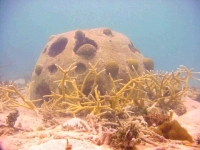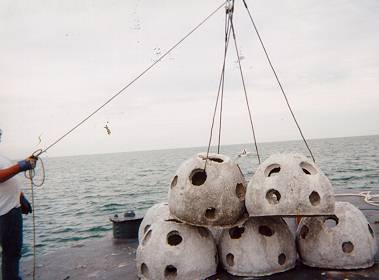The Star, “The People’s Paper” Malaysia
April 11, 2002 No. 154621
TRENDS
HEAVENLY NICHE
BURIALS
While it’s common to bury the dearly departed in cemetery plots or keep their ashes in a columbarium, views of death and dying are changing and more people are thinking outside the box reports DON OLDENBURG.

Cremated remains are incorporated in concrete reef balls to
make artificial reefs. Alternative dispositions such as reef burials could
change the face of the burial business.
Stephen Emery pulled himself slowly down the motorboat's anchor chain, 20
feet to the dark bottom of Florida's Sarasota Bay. Above, the choppy waters had
made the two-mile ride bumpy and mucked up the water, but as he touched bottom
the visibility cleared some, and "there it was," he recalled.
The anchor had hooked into a hole in a large concrete dome, one of four
settled into the sand, ranging from two to four feet in diameter. Together they
made an artificial reef, which was so completely covered by algae, barnacles,
soft coral and small sponges that Emery couldn't find the bronze plaque he was
looking for.

A company called Eternal Reefs (www.eternalreefs.com) sinks reef balls which include the cremated remains of a loved one, in approved ocean locations to provide the foundation for a coral reef. "We provide a place to go to, as you'd have in a cemetery, except it's in the water," says a company co-founder
The plaque bears his twin brother's name. The cremated remains of David
Emery, who died at 32 when a drunk driver hit his motorcycle, are in one of
those algae-covered concrete domes.
"The growth was phenomenal," said Stephen, an environmental
scientist who made his first scuba dive to visit his brother last Dec. 23.
"I felt, hey, this isn't too bad. I was near where Dave is. He's part of
that reef. And I felt that's where he'd want to be."
Not long ago, people seemed satisfied to bury their dearly departed in
cemetery plots or keep their ashes on the mantel. But as views of death and
dying change, more people are thinking outside the box. A growing number
believe alternative dispositions such as reef burials could change the face of
the burial business.
Last weekend the Cremation Association of North America's two-day seminar in
Las Vegas concluded with a session called "It's Not Your Grandparents'
Funeral." On the agenda, along with aesthetic choices such as Eternally
Yours memorial paintings that blend the deceased's ashes into watercolors, were
several "green" options. Celebration Forest in Idaho will plant and
care for a memorial tree, and scatter the ashes around its trunk. A
"nature preserve" cemetery in South Carolina buries actual bodies in
an ecologically sound way. And people who love the ocean can choose artificial
reefs.
"It's a niche type of thing, but the niche is growing," said Jack
Springer, the cremation association's executive director.
For decades, cremation was the niche. But the percentage of bodies cremated
went from less than 7 percent in 1975 to 25 percent in 2000 in the United
States, according to the association. Despite the gross abuses discovered last
month at the Tri-State Crematory in Georgia, cremation rates are expected to
rise steadily and top 50 percent in 25 years. Why? It costs less, it doesn't
waste land, and it's simpler, said Springer.
But disposing of a loved one's ashes provides an opportunity to deal with
death in a more meaningful way, even on Earth-friendly terms. George Frankel,
co-founder of Eternal Reefs, the company that buried Dave Emery's ashes, said
people are beginning to consider the impact their remains will have on the
environment.
"People want to continue making a difference long after their
deaths," said Frankel. "They come to the end of their lives searching
more and more for what their contribution was, should've been or could be. And
then they find an option like ours."
Based in Decatur, Ga., Eternal Reefs is a spinoff from the Reef Ball
Development Group, a company created in 1992 by a group of ecology-conscious
diving buddies who wanted to revitalize endangered coral reefs. Hired primarily
by governments, the company has sunk more than 100,000 "reef balls"
in 1,500 locations worldwide to build artificial reefs.
"Each reef ball is designed to last 500 years," Frankel said of
the grainy gray domes that look like giant whiffle ball halves. Six inches
thick and made from marine-grade, pH-neutral concrete, reef balls range from
400 to 4,000 pounds.
But it wasn't until four years ago, when one partner's dying father asked to
be buried in an artificial reef, that Reef Balls got into the business of
ecologically beneficial burials. They mixed his ashes with concrete, molded it
into a reef ball and sank it off Sarasota -- where, today, it is so overgrown
and populated with sea life that it is unrecognizable as a grave site.
Since then, Eternal Reefs has "deployed" the ashes of nearly 100
people off Charleston, S.C., and Sarasota, at a cost of $850 to $3,200 each.
This summer it will begin building memorial reefs off Fort Lauderdale and Marco
Island, Fla.
"We provide a place to go, as you'd have in a cemetery -- except it's
in the water," said Frankel. "Our families say they get beachfront
property for an eternity."
Lynne Bryant discovered the Eternal Reefs Web site when seeking a water
location where she might sink the urn containing her first husband's ashes. Lee
Bryant died from a stroke in 1981, a month after they were married. "We
had intended to sail around the world together," said Bryant, of League
City, Tex. "I knew that Lee wanted to be buried at sea."
Facing state and federal laws that regulate the scattering of ashes, Bryant
kept her husband's ashes for 20 years. Last June she watched from a rental boat
two miles off Sarasota as Eternal Reefs deployed his remains in a reef ball as
she scattered dried flowers from their wedding on the water.
Frankel said state and local governments that normally pay for reef building
have been supportive of the memorial reefs. "We're helping the people make
a contribution to the environment," he said. "The state gets these
reef balls for free. And these are going to be public and recreational reefs
that anyone can enjoy."
Eternal Reefs isn't alone in the notion of going into that good night while
helping the Good Earth. Billy and Kimberley Campbell founded the nation's first
"green burial" nature cemetery in 1996 on land they owned at Ramsey
Creek near Westminster, S.C. Their mission: to provide less expensive burial
options that protect and restore woodlands.
Interment costs about $2,300, less than half the cost of a traditional
funeral. Bodies cannot be embalmed, and caskets must be nontoxic and
biodegradable. No headstones -- only flat markers. Families are encouraged to
be involved, from making the casket to digging the grave. So far, 14 people
have been buried there.
"This is the way people used to be buried," and still are in other
cultures, Kimberley Campbell said. Instead of the dust-to-dust transformation
taking centuries due to embalming chemicals, bodies buried at the Ramsey Creek
Memorial Nature Park start renourishing nature faster.
Last month Bonnie Ramey buried her husband, Charles, a Vietnam veteran, in
the plot they bought at the nature park a year ago. "We liked it because
it preserves the land and animals," said Ramey, 49, who lives three miles
away. "That's why we picked it. Pretty soon we're going to run out of
places for the animals to live."
The way Donald Edward Moss II sees it, "we're only here to borrow and
use while we're here, and then return it in as good as shape as possible when
we go."
A Walhalla, S.C., interior designer, Moss is back this week in Oconee
Memorial Hospital, in nearby Seneca, battling metastatic lung cancer. He has
chosen a site at Ramsey Creek where he wants his ashes scattered. "I want
to return to the Earth as soon as possible after I die," said Moss.
"I like the idea of returning to the water and the land to be a nutrient.
We only have so much earth left and I have a grandson who is 2 years old."
Billy Campbell said that while business at the preserve has been slow, its
Web site (MemorialEcosystems.com) gets 400 to 500 hits per day. He plans to
make the company nonprofit and expand with a 300-acre project in the Florida
Panhandle. "Our dream is that people will come to think of the preserves
as great places to visit, where they can learn about nature, get married and,
oh, yeah, be buried when they die," he said.
Linnea Rogers-Notton read about Ramsey Creek in the Sierra Club newsletter.
"I got very excited," said Rogers-Notton, 67, a Bethesda native and
the founder of People for Preservation, an environmental advocacy group in
Mount Pleasant, S.C.
Rogers-Notton chose a burial space with a mountain view. "It's a
philosophical as well as a practical matter to me," she said. "And I
like that for $200 more you can have your burial site restored with native wild
plants so eventually no one will know there was anything there."
Environmental groups are just beginning to embrace the concept. The December
issue of the journal Conservation Biology, in an article titled "Toxic Burials:
The Final Insult," touted the potential for "green" and reef
burials. "Alternatives exist," it said. "Graveyards can be
ecologically significant."
Greenpeace has been more focused on the burial of nuclear waste. "It's
treading lightly, using as little as possible and putting back -- and, in that
sense, I think you'd see support for it here," Greenpeace spokesman Craig
Culp said. "But I just haven't heard that much about it and don't know of
any campaign on that issue." -LAT-WP